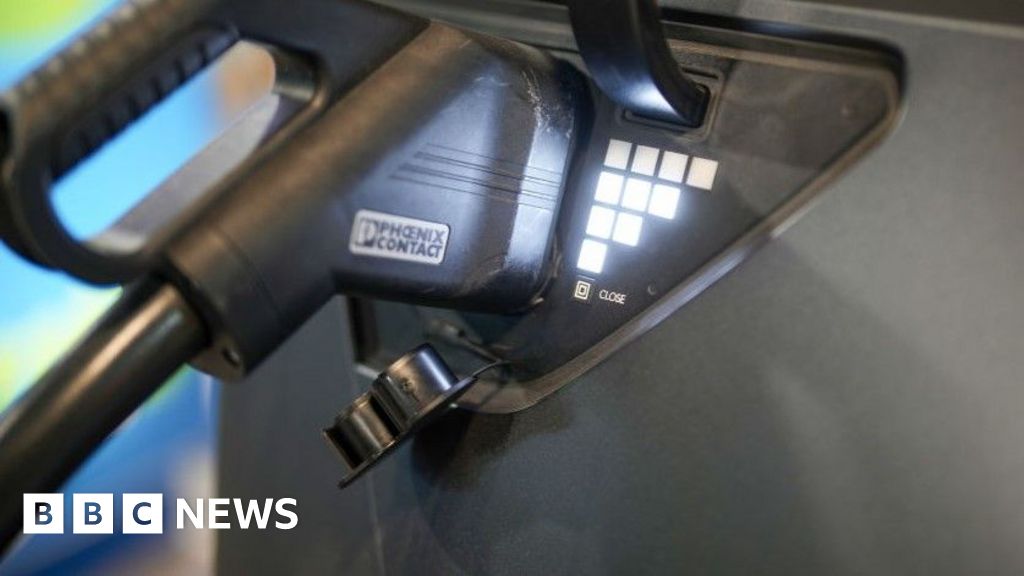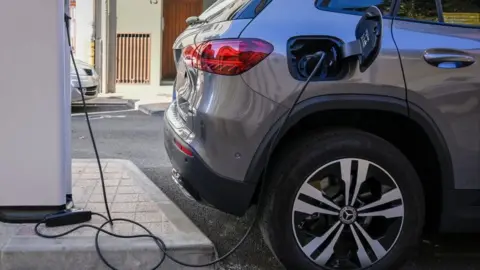Business
How to tell the health of a battery in a used EV

Chris BaraniukTechnology Reporter
 Corbis via Getty Images
Corbis via Getty ImagesWhen Kerry Dunstan and his partner set out to buy a new electric car this summer, one of the questions they asked was, “How’s the battery?”.
They’d found a 2021 Nissan Leaf with just 29,000 miles on it, and the dealer told them the condition of the battery, or its state of health (SOH), was still around 93%.
The couple were sold. For £12,500, they got an EV with a big boot and plenty of room for passengers.
Though Mr Dunstan, a cabinetmaker who also owns a somewhat snazzier electric Volvo SUV, hasn’t quite fallen in love with the aging Leaf.
“I like sporty, jazzy cars – and it’s just a bit ‘meh’,” he says.
However, he adds the Leaf has performed exactly as expected during the three months they’ve owned it.
It used to be that age and mileage were the two headline details pored over by would-be buyers of second-hand cars. But as more people shift to electric, scrutinising the health of a car’s battery has become arguably even more important.
How has that battery been treated? Did the last owner regularly fast charge it to 100%, for example? That has the potential to shorten an EV battery’s lifespan.
This battery black box problem has put some consumers off buying a second-hand EV. But battery analytics firms say they can reveal the condition of an old EV’s battery with high accuracy. And industry experts say some EVs are lasting longer than many predicted.
Take Mr Dunstan’s Nissan Leaf. This is a model of EV built without the kind of sophisticated, liquid-based battery cooling system common to many other EVs. While Nissan has rectified this in the latest generation of Leafs, earlier models show a considerable shortening of their range year by year, according to data analysed by US insurance and research firm NimbleFins.
Mr Dunstan is unfazed. “I charge both my EVs to 100% and I put them on charge when I need to charge them – I don’t worry about it,” he says.
 Kerry Dunstan
Kerry DunstanFor people in the market for a second-hand EV who are plagued by battery anxieties, however, Austria-based firm Aviloo says it has a solution. “We really can, completely independently, determine the state of health of a battery,” says chief product officer, Patrick Schabus.
Aviloo is one of several battery analytics businesses in the market. The company, which provides battery health certificates for major UK outlet British Car Auctions, offers two products.
There’s a premium test, where EV owners plug a data logging box roughly the size of a glasses case into their car so that it can monitor battery performance while they use the car over a few days, going from 100% charge down to 10%.
Or, they can opt for a quicker flash test, which uses a different box to suck up data from the car’s battery management software and then analyse it with the help of a computer model. “We can do this at a standstill in under two minutes,” says Mr Schabus.
The premium test observes battery discharge closely, picking up fluctuations in current or voltage, and can reveal extra detailed information about the health of individual cells in the battery, says Aviloo.
Marcus Berger, Aviloo’s chief executive, says his company’s analytics results sometimes diverge “substantially” from the battery SOH percentages produced by some cars’ own built-in analytics systems.
He challenges conventional wisdom that batteries with an SOH below 80% are too far gone: “An EV with a state of health below 80% can still be a great car… It just needs to be priced [appropriately].”
In New Zealand, EV owner Lucy Hawcroft, who works in a sustainability role for an infrastructure firm, bought a Nissan Leaf with her husband roughly three years ago. She recalls getting an SOH result of 95% or so from the dealership. But a year later an independent mechanic checked the SOH again for them.
“It dropped quite a bit,” she recalls. “My husband was a bit surprised, or concerned, about that.”
However, the car still has a range of around 160km (100 miles) when fully charged. The pair mostly use it for short journeys of up to 10km. Mrs Hawcroft says she has friends whose EVs have much bigger ranges, of around 400km: “That would be ideal.”
For David Smith, sales director at Cleevely Electric Vehicles in Cheltenham, being able to analyse used EVs’ batteries in detail is a deal-maker. Most customers ask for this information, he says. His company uses SOH reports from ClearWatt, another battery analytics firm.
“They’re completely independent. We can’t interfere with the reports,” he says. “Once customers have seen the report, that aids the sale nine times out of 10.”
Matt Cleevely, managing director at Cleevely Electric Vehicles, adds that it’s often possible to replace groups of cells or modules within a battery pack – far cheaper than installing a whole new battery.
 Lucy Crawford
Lucy CrawfordAs for how you should charge your own EV in order to best take care of its battery, Simona Onori at Stanford University says, “There is likely a sweet spot between frequent fast charging and avoiding it altogether.” However, she adds that, to her knowledge, this is not something that has yet been thoroughly studied.
Despite some consumers’ wariness, battery technology has noticeably improved in recent years, says Max Reid, head of battery costs at market research firm CRU. “The older batteries might last maybe 500 to 1,000 [charging] cycles,” he explains. “Now, it’s 10,000 cycles in some of these new EV cells coming out.”
Batteries that are no longer good enough for the EV they were designed for can still be useful, says Paul Chaundy at Second Life EV Batteries, in Dorset. For instance, some of his customers are businesses that use former EV batteries to store electricity at their premises. They might have, say, six electric forklifts but a grid connection only large enough for charging ports to supply two or three of the forklifts.
Regarding the varying methodologies car manufacturers use to generate SOH reports for their own vehicles, Mr Chaundy says, “We need more standards around that, I think.”
Business
Eli Lilly cuts cash prices of Zepbound weight loss drug vials on direct-to-consumer site

The Eli Lilly logo appears on the company’s office in San Diego, California, U.S., Nov. 21, 2025.
Mike Blake | Reuters
Eli Lilly on Monday said it is lowering the cash prices of single-dose vials of its blockbuster weight loss drug Zepbound on its direct-to-consumer platform, LillyDirect, building on efforts by the company and the Trump administration to make the medicine more accessible.
The announcement also comes weeks after chief rival Novo Nordisk unveiled additional discounts on the cash prices of its obesity and diabetes drugs.
Starting Monday, cash-paying patients with a valid prescription can get the starting dose of Zepbound vials for as low as $299 per month on LillyDirect, down from a previous price of $349 per month. They can also access the next dose, 5 milligrams, for $399 per month and all other doses for $449 per month, down from $499 per month across those sizes.
Zepbound carries a list price of roughly $1,086 per month. That price point, and spotty insurance coverage for weight loss drugs in the U.S., have been significant barriers to access for some patients.
Eli Lilly’s announcement comes just weeks after President Donald Trump inked deals with Eli Lilly and Novo Nordisk to make their GLP-1 drugs easier for Americans to get and afford. The agreements will cut the prices the government pays for the drugs, introduce Medicare coverage of obesity drugs for the first time for certain patients and offer discounted medicines on the government’s new direct-to-consumer website launching in January, TrumpRx.
But Eli Lilly’s deal with Trump centers around lowering the prices of a different form of Zepbound – a multi-dose pen – after it wins Food and Drug Administration approval.
That means Eli Lilly’s Monday announcement around cutting prices on the existing single-dose vials could allow more patients to get discounted treatments more quickly.
“We will keep working to provide more options — expanding choices for delivery devices and creating new pathways for access — so more people can get the medicines they need,” said Ilya Yuffa, president of Lilly USA and global customer capabilities, in a statement.
Eli Lilly’s stock, which has climbed more than 36% this year, fell nearly 2% on Monday. Its meteoric rise due to the success of Zepbound and its diabetes injection Mounjaro vaulted it to becoming the first health-care company to hit a $1 trillion market value last month. Though cutting prices means lower revenue per medication sold, Eli Lilly’s sales — and shares — have continued to soar through past pricing announcements as demand balloons.
With single-dose vials, patients need to use a syringe and needle to draw up the medicine and inject it into themselves. Eli Lilly first introduced that form of Zepbound in August 2024.
It’s unclear how many patients are currently using single-dose vials of Zepbound. But Eli Lilly previously said that direct-to-consumer sales now account for more than a third of new prescriptions of Zepbound.
Novo Nordisk earlier this month lowered the price of its obesity drug Wegovy and diabetes treatment Ozempic for existing cash-paying patients to $349 per month from $499 per month. That excludes the highest dose of Ozempic.
The company also launched a temporary introductory offer, which will allow new cash-paying patients to access the two lowest doses of Wegovy and Ozempic for $199 per month for the first two months of treatment.
Business
OBR chairman resigns over Budget leak

The chairman of the Office for Budget Responsibility (OBR) has resigned over the early publication of the watchdog’s forecasts.
Richard Hughes said he was resigning to allow the OBR to “quickly move on from this regrettable incident”.
His resignation follows publication of a report that described the leak as “the worst failure in the 15-year history of the OBR” and strongly criticised the watchdog’s processes for protecting sensitive information.
In a letter to the Chancellor and the chairwoman of the Commons Treasury Committee, Mr Hughes said he took “full responsibility” for “the shortcomings identified in the report”.
He said: “By implementing the recommendations in this report, I am certain the OBR can quickly regain and restore the confidence and esteem that it has earned through 15 years of rigorous, independent economic analysis.”
Mr Hughes has served as chairman of the OBR since 2020 and was reappointed to the job for a second five-year term in July this year.
Speaking in the Commons as the news of the resignation broke, Chief Secretary to the Treasury James Murray offered the Government’s thanks to Mr Hughes “for his dedication to public service”.
Later, the Chancellor herself offered her thanks for Mr Hughes’ “many years of public service”, adding: “This Government is committed to protecting the independence of the OBR and the integrity of our fiscal framework and institutions.”
Conservative leader Kemi Badenoch accused the Chancellor of using Mr Hughes as a “human shield” and called on Rachel Reeves to resign.
Liberal Democrat Treasury spokeswoman Daisy Cooper said Mr Hughes was “a dedicated public servant” who had “rightly taken responsibility for a failure on his watch”, adding the OBR needed to learn from its “catastrophic error”.
Treasury Committee chairwoman Dame Meg Hillier also thanked Mr Hughes, saying: “I commend his decision to take full responsibility for the incident and I wish him well for the future.”
The Treasury said it would begin the process of finding a replacement for Mr Hughes “in the coming weeks”.
The OBR launched an investigation after official forecasts were uploaded to the watchdog’s website, releasing details of the Budget almost an hour early.
In a report published on Monday, the OBR said the leak had been “seriously disruptive to the Chancellor, who had every right to expect that the (forecasts) would not be publicly available until she sat down at the end of her Budget speech”.
Noting Mr Hughes had already “rightly” apologised for the leak, the report said it was “not a case of intentional leakage” or a matter of pressing publish too early.
The OBR said it was caused by two errors linked to the WordPress publishing site it used.
The report into the incident said that, while it knew web addresses for its files follow a pattern, it assumed “the protections provided” by WordPress “would ensure it could not be accessed”.
But two configuration errors were the technical causes of the premature access.
The forecast for the last spring statement in March was also “accessed prematurely” on one occasion, the report noted, but concluded that no activity appeared to have been taken as a result and the most likely explanation is “benign”.
The report recommended a review of the watchdog’s processes for publishing such documents.
“To rebuild trust, the leadership of the OBR must take immediate steps to change completely the publication arrangements for the two important and time-sensitive documents containing the results of its biannual forecasts that it publishes in a normal year, and review arrangements for all other publications,” the report said.
One option would be for the watchdog to use the Government’s digital architecture but publish when it wants.
Another would be to have the Treasury publish the forecasts for the Budget and spring statement, but this would only work if safeguards for “real and perceived independence” could be put in place.
There may need to be an interim solution, the report noted, but said new arrangements must be in place in time for the next statement in spring 2026.
Business
OGRA Announces LPG Price Increase for December – SUCH TV

The Oil and Gas Regulatory Authority (OGRA) has approved a fresh increase in the price of liquefied petroleum gas (LPG), raising the cost for both domestic consumers and commercial users.
According to the notification issued, the LPG price has been increased by Rs7.39 per kilogram, setting the new rate at Rs209 per kg for December. As a result, the price of a domestic LPG cylinder has risen by Rs87.21, bringing the new price to Rs2,466.10.
In November, the price of LPG stood at Rs201 per kg, while the domestic cylinder was priced at Rs2,378.89.
The latest price hike is expected to put additional pressure on households already grappling with rising living costs nationwide.
-

 Sports1 week ago
Sports1 week agoWATCH: Ronaldo scores spectacular bicycle kick
-

 Entertainment1 week ago
Entertainment1 week agoWelcome to Derry’ episode 5 delivers shocking twist
-

 Politics1 week ago
Politics1 week agoWashington and Kyiv Stress Any Peace Deal Must Fully Respect Ukraine’s Sovereignty
-

 Business1 week ago
Business1 week agoKey economic data and trends that will shape Rachel Reeves’ Budget
-

 Politics1 week ago
Politics1 week ago53,000 Sikhs vote in Ottawa Khalistan Referendum amid Carney-Modi trade talks scrutiny
-

 Tech6 days ago
Tech6 days agoWake Up—the Best Black Friday Mattress Sales Are Here
-

 Fashion1 week ago
Fashion1 week agoCanada’s Lululemon unveils team Canada kit for Milano Cortina 2026
-

 Tech1 day ago
Tech1 day agoGet Your Steps In From Your Home Office With This Walking Pad—On Sale This Week





